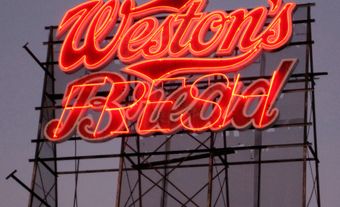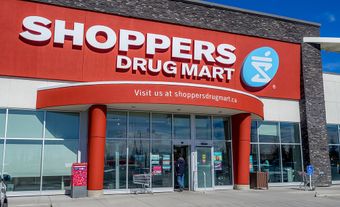Loblaw Companies Limited is a subsidiary of George Weston Limited. It operates supermarkets, drug stores, liquor stores and clothing stores. In 2023, Loblaw Companies Ltd. reported $59.53 billion in revenue and operated more than 2,500 stores, making it Canada’s largest food and drug retailer. It is a public company headquartered in Brampton, Ontario. It trades on the Toronto Stock Exchange under the symbol L.

|
Loblaw retail chains |
Loblaws, Zehrs, Your Independent Grocer, Provigo, Atlantic Superstore, Fortinos, Dominion, Independent City Market, Freshmart, Valu-mart, ARZ Fine Foods, Real Canadian Wholesale Club, T&T Supermarket, Real Canadian Liquorstore, Real Canadian Superstore, No Frills, Maxi, Extra Foods, Pharmaprix and Shoppers Drug Mart. |
|
Loblaw brands |
No Name, President’s Choice, Life Brand and Joe Fresh. |
Founding
From 1910 to 1919, grocery industry veteran Theodore Pringle Loblaw ran Toronto-based Loblaw Stores. It was a traditional full-service grocery chain. After Loblaw left the company, he spent a year working as a merchandise manager for the United Farmers’ Co-operative Company (UFCC), which was affiliated with the United Farmers of Ontario political party. Loblaw Stores was sold to future rival Dominion Stores Limited.
While with the UFCC, Loblaw re-entered the grocery business. He and business partner John Milton Cork opened the first Loblaw Groceterias store in Toronto’s Junction neighbourhood in 1919. The “groceteria” concept was inspired by cafeterias and new self-service stores in the United States such as the Piggly Wiggly chain. Customers could pick their own packaged foods at their own pace rather than wait for a clerk. They paid cash on the spot instead of running up monthly tabs. They also took their groceries with them instead of getting home delivery.

Loblaw Groceterias Limited, store No. 1, 2923 Dundas Street West, Toronto, Ontario, c. 1919.
With lower overhead costs than its competitors, Loblaw Groceterias grew quickly. By 1929, it had 87 stores across Ontario. To serve this growth, it opened a $1.5-million art deco head office in Toronto in June 1928. This headquarters included office and warehouse space, bakeries, food-packaging facilities, a coffee roastery and a rail connection to distribution routes. It had recreational facilities for employees, including a bowling alley and a performance hall. The company also expanded into the United States, opening stores in western New York State in 1924 and Chicago in 1928.
T. P. Loblaw had a near-fatal case of pneumonia after being thrown from a horse in 1928. The illness caused him to re-evaluate his financial holdings. In 1929, he cancelled a planned merger with Dominion when the stock market crashed and his health improved. The company sold off some of its American holdings in 1932.
George Weston Limited
When Theodore Pringle Loblaw died in 1933, John Milton Cork became president. Cork ran Loblaw Groceterias until 1947. That year, baking company George Weston Ltd., led by W. Garfield Weston, began purchasing shares in Loblaw Groceterias. Weston gained a controlling interest by 1953.
Weston formed Loblaw Companies Limited in 1956 as part of a corporate reorganization. The subsidiary handled Weston’s grocery business. In the first 14 years under Weston, Loblaw Companies grew with more than $200 million worth of takeovers. It bought food distributors and grocery chains including Power Supermarkets (1953), Pickering Farms (1954), O.K. Economy Stores (1955), National Grocers (1955), Kelly Douglas and Company (1958), Atlantic Wholesalers (1959), Dionne (1959) and Zehr’s Markets (1963). Loblaw also acquired controlling interests in the G. Tamblyn drug store chain and Sayvette discount department stores. In the United States, Loblaw Groceterias bought the Loblaw Inc. chain of stores from George Weston Ltd. in 1953. George Weston Ltd. bought National Tea in 1955.

During this period, Loblaw hid from investors the extent of its holdings in other food distributors and retailers. In fall 1966, a special joint committee of the House of Commons and the Senate on consumer credit and the cost of living requested that information. Several newspapers published a complex flow chart of Loblaw’s holdings in December 1966.
1970s Revitalization
Loblaw had begun to lose its edge over competitors like Dominion and Steinberg's by the end of the 1960s. Loblaw-owned stores were comparatively small and outdated in their look. Sales per square foot were declining. Subsidiaries received little guidance from Loblaw management. During a price war that affected Ontario grocers in late 1970, Loblaw’s share of total grocery sales in its home base of Toronto fell from 30 per cent to 15. As debt piled up, bankruptcy loomed.
To turn the company around, Garfield Weston named his youngest son, W. Galen Weston, as CEO of Loblaw Companies Ltd. in February 1972. Galen Weston oversaw a year-long analysis of the many companies within Loblaw. Following that, Loblaw launched a major renewal project. Between 1973 and 1975, it closed nearly two-thirds of its stores, including almost half of those in Ontario. It renewed its image, replacing yellow store exteriors with brown and introducing the iconic red-and-orange “L” logo. Designer Don Watt gave store interiors and house-brand products a fresher appearance. Loblaw adopted a new slogan, “More than the price is right,” and it hired William Shatner as a television spokesperson.
The turnaround proved successful. Revamped stores saw their sales double or triple. Loblaw put greater focus on the grocery business after it closed Sayvette and sold G. Tamblyn to British pharmacy chain Boots the Chemists in 1977.
No Name and President’s Choice
Loblaw reorganized its upper management in 1976. Two men Galen Weston had hired soon after becoming CEO assumed key roles. Richard Currie became president of Loblaw Companies Ltd, a role he would hold until 2000. Dave Nichol became president of Loblaws Ltd. (the Ontario supermarket division) and soon replaced William Shatner as the company’s public face.
In March 1978, Loblaw launched the No Name line of generic products. These basic items were sold at low cost in Don Watt’s clean, simple black and yellow packaging. No Name looked sleek compared to the ultra-cheap packaging of the few other generics on the market. Later that year, Loblaw opened the first No Frills store in Toronto. Through minimal decor, charging for shopping bags and having customers pack their own purchases, No Frills kept its overhead costs low. It passed savings to consumers with low prices on products.
To appeal to customers who wanted higher-quality products at affordable prices, the President’s Choice line was introduced in 1984. The next year, Dave Nichol became president of Loblaw International Merchants. This division was tasked with developing new products. Until he left the company in 1993, Nichol was also the face of the Insider’s Report, a humorous flyer written by former Toronto Star restaurant critic Jim White. Insider’s Report created excitement about the latest private-brand products. The most successful item was the President’s Choice Decadent Chocolate Chip Cookie. Introduced in 1988, it became the best-selling cookie in Canada by 1991.
All these efforts combined to make Loblaws Supermarkets the largest, most profitable grocer in Canada. However, Loblaw continued to struggle in the United States. The company gradually scaled back its US business. It left the American market completely when it gave up its remaining interest in National Tea in 1995.
21st Century
In 2006, Loblaw struggled with supply chain problems and recorded its first loss in almost two decades. Galen G. Weston (W. Galen Weston’s son) became executive chairman of Loblaw Companies Limited (see Galen Weston Jr. Takes over at Loblaws). Galen G. Weston, working with president Allan Leighton, refocused the company on food retailing. They reduced the emphasis on general merchandising, while developing specialty areas such as the Joe Fresh clothing line in 2006 (see Joe Mimran). In 2007, Loblaw returned to profitability.
In March 2014, George Weston Ltd. acquired Canadian pharmacy and retail chain Shoppers Drug Mart for $12.4 billion. Shoppers became a separate division of Loblaw and began to stock President’s Choice and No Name products, as well as more fresh foods in select stores. The deal helped Loblaw more than double its profit in the last quarter of 2014 compared to the same quarter the previous year. In February 2018, Loblaw merged the Shoppers Optimum loyalty rewards program with the PC Plus program to create PC Optimum. It was later rolled out to Esso and Mobil gas stations.

Loblaws at Bayview Village Shopping Centre in Toronto. Photo taken 8 April 2014.
In 2018, Loblaw sold its Choice Properties division to George Weston Ltd. This reorganization saw the real-estate trust become the parent company’s third subsidiary. Choice Properties owns, manages and develops retail and commercial properties across the country. These include stores operating under various Loblaw banners.
Bread Price Fixing Scandal
On 19 December 2017, George Weston Ltd. and Loblaw Companies Ltd. revealed that both companies had participated in a bread price fixing scheme between 2001 and 2015. According to George Weston Ltd., the price fixing arrangement was organized industry-wide, with companies coordinating regular price increases together.
Amounting to “consumer fraud” in the eyes of the Canadian Competition Bureau (see Competition Policy), price fixing occurs when two or more companies in a free market agree to either raise, lower or set the price of a particular good. Since companies change their prices to remain competitive with others, price fixing is often difficult to detect. For this reason, the Competition Bureau usually relies on a company to come forward.
In this case, Weston and Loblaw came forward in 2015, when they alleged they first learned of the scheme. They cooperated with the Competition Bureau in exchange for immunity, which protected both companies from any fines or other penalties, including jail time. To ease consumer anger, Loblaw offered customers $25 gift cards.
In late 2017, two $1-billion class action lawsuits were filed against Weston, Loblaw and several other companies believed to be part of the scheme. In 2024, Loblaw and Weston jointly announced that they will pay a total settlement of $500 million to resolve class action lawsuits regarding their role in the bread price fixing scheme. As part of the settlement, Weston will pay $247.5 million in cash. Loblaw will pay $252.5 million, which will be comprised of $156.6 million in cash and credit for $96 million, which was already paid to customers in the form of $25 gift cards (the Loblaw Card program).
Key Terms: Loblaw Companies Limited
Controlling interest – Ownership of enough of a company’s stock to give the shareholder control of the business.
Holdings – The stocks, property or other financial assets of a company.
Overhead costs – The expenses of running a business, not including the costs of labour. Examples include rent and marketing.
Share – A unit of ownership in a company. A shareholder is an individual or business that owns shares.
Subsidiary – A company that is owned by another company (usually called the parent company).

 Share on Facebook
Share on Facebook Share on X
Share on X Share by Email
Share by Email Share on Google Classroom
Share on Google Classroom






